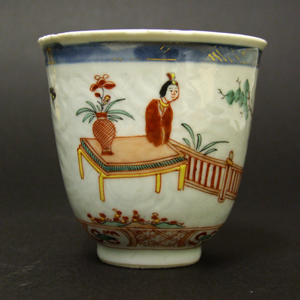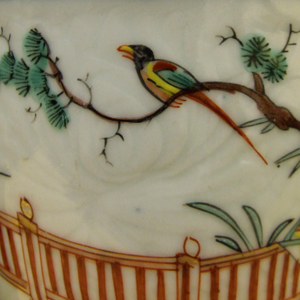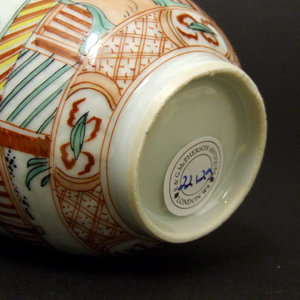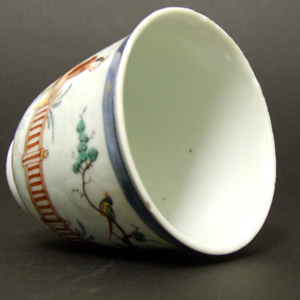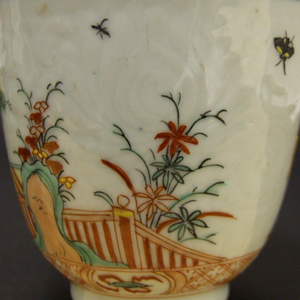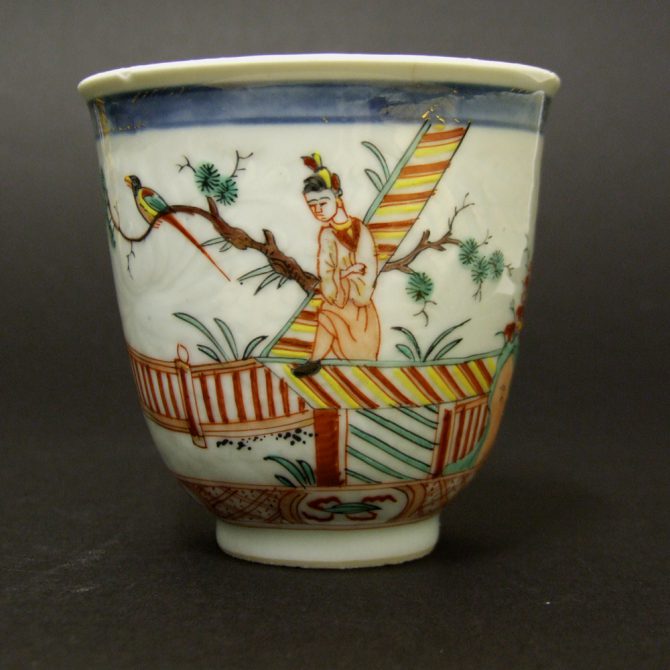
Late KANGXI or YONGZHENG c.1710 – 1740 Dutch Decorated Chinese Porcelain
An Early 18th Century Chinese Export Porcelain Beaker, Decorated with a Large Incised Band of Flowering Lotus and Simple Under-Glazed Cobalt Blue Border with a Gilded Diaper Pattern. Enamelled in Holland c.1730-1740 with a Scene from Act III of `The Romance of the Western Chamber` by the Yuan Dynasty Playwright Wang Shifu (c.1260-1336). It Depicts Zhang Sheng, a Young Scholar Clambering Over a Wall to Meet His Young Lover Cui Yingying. The Branches of Weeping Willow have been Replaced with Pine and the Perspective of the Wall Misunderstood. The Play Refers to “The Branches of Weeping Willow and The Flowers Act as Curtains, the Green Moss Serves as a Specious and Embroidered Couch”.
SOLD
- Condition
- One long clean rim crack c.35mm. Rim fritting.
- Size
- Height : 8.5 cm (3 1/2 inches)
- Provenance
- N/A
- Stock number
- 22129
Information
European Decorated Chinese Porcelain :
For convenience it might be practical to divide European decoration of Chinese export porcelain into three groups. Firstly where the European decoration had been used to augment the existing Chinese enamel, blue and white or incised decoration, see stock number 21823 for an example. This was used to enliven designs that were rather plain or indeed sometimes where the Chinese porcelain was undecorated to start with. The second group can be termed `over-decorated`, where the European enamelling was added partly or wholly on top of the existing Chinese enamels, sometimes taking no notice of the original design, see stock number 21567 for an example. The last and by far the least common, where the original Chinese enamels have been partly or entirely removed so as to leave some space or a `blank canvas` for the European decorator. Chinese porcelain with European decoration is rarely encountered where the whole of the original design has been removed because it must have been a very laborious and expensive solution to improving the object, stock number 22037 is the only example were have had, you can see this in our `Sold` items. It appears that this was made as a replacement to match a pre-existing Chinese porcelain dish. The point of adding European decoration was, of cause, to increase the desirability of the Chinese porcelain object and so increase the profit of the merchant. One of these techniques would have be selected to improve the saleability of the porcelain by making it more attractive and more in keeping with current fashions.
Romance of the West Chamber / Xi Xiang Ji :
The scene of Zhang Sheng, a young scholar clambering over a wall to meet his young lover Cui Yingying appears frequently on Chinese porcelain of the 17th and 18th century. This is the most recognisable of a large group of designs taken from the West Chamber. It is based on a scene in Act III of this famous Chinese literary work written by the Yuan Dynasty playwright Wang Shifu (c.1260-1336) it was set during the Tang Dynasty (618-907). It has had an enduring appeal, some of the very first narrative scenes decorated on Chinese blue and white porcelain are taken from this story, they were produced during the Yuan dynasty in the mid-14th century and the designs have been used ever since. The story is of young lovers consummating their love without parental approval, and has been called `China`s most popular love comedy` and a `lover`s bible`. At the same time, some have called it potentially dangerous, as there are stories of readers pining away under its influence. There are problems for those of us who wish to identify individual scenes depicted in the West Chamber, these are clearly set out by Craig Clunas in his excellent paper presented to the O.C.S. (A Literary Theme in Chinese Porcelain Decoration, a paper read by Mr Craig Clunas on 11th May 1982, Transactions of the Oriental Ceramics Society 1981-1982). He points out that it is particularly difficult to identify the designs produced during the Qing dynasty. One reason given is there are few reproductions of later editions of the work to compare the designs too, but more problematically the designer, as opposed to the painter, might well have interpreted the scene without any direct reference to the original woodcut. The designs taken from the West Chamber were especially popular during the Kangxi period (1662-1722) particularly in blue and white but they also occur frequently on famille verte of the period. The scene of Zhang Sheng clambering over a wall can be found on blue and white porcelain teaware recovered from the Ca Mau Cargo (Yongzheng period 1723-1735), this particular design was also produced at the period in famille rose enamels.
